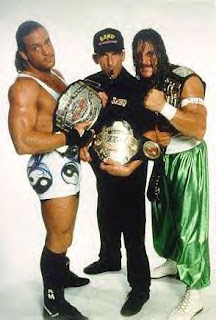 |
| Paul Heyman |
 |
| Shane Douglas |
 |
| Tommy Dreamer |
 |
| The Sandman |
 |
| Extreme Francine |
 |
| Taz |
 |
| Rob Van Dam & Sabu |
Coralluzzo was interviewed after the event and declared that Douglas would be the world champion of the NWA "whether he likes it or not", calling Douglas' actions a "disgrace" and said he would move to have Douglas stripped of both the NWA World Heavyweight Championship and the Eastern Championship Wrestling Heavyweight Championship, calling him "undeserving" of both titles. Gordon made the following announcement on the next edition of NWA-ECW programming.
“I listened with great interest as the representative of the NWA board of directors took it upon himself to inform you that they have the power to force NWA-Eastern Championship Wrestling not to recognize The Franchise, Shane Douglas, as a world heavyweight champion. Well, as of noon today, I have folded NWA-Eastern Championship Wrestling. In its place will be ECW- Extreme Championship Wrestling- and we recognize The Franchise, Shane Douglas, as our World Heavyweight Champion. And we encourage any wrestler in the world today to come to the ECW to challenge for that belt. This is the ECW, Extreme Championship Wrestling, changing the face of professional wrestling.”
 |
| Raven |
 |
| The Sandman |
 |
| Bam Bam Bigelow, Extreme Francine, Shane Douglas, and Chris Candido |
 |
| Taz |
 |
| Mike Awesome |
 |
| Raven |
 Following Tommy Dreamer's debut in Total Nonstop Action Wrestling, a new stable was formed called EV2.0 consisting of former ECW alumni. TNA President Dixie Carter agreed to give the stable their own reunion show at TNA's annual Hard Justice Pay Per View. Billed as the last ECW reunion show, Hardcore Justice aired on August 8, 2010. EV2.0 remained on the active roster for the remainder of the year. The Hardcore Justice Pay Per View returned the following year but was not an ECW reunion.
Following Tommy Dreamer's debut in Total Nonstop Action Wrestling, a new stable was formed called EV2.0 consisting of former ECW alumni. TNA President Dixie Carter agreed to give the stable their own reunion show at TNA's annual Hard Justice Pay Per View. Billed as the last ECW reunion show, Hardcore Justice aired on August 8, 2010. EV2.0 remained on the active roster for the remainder of the year. The Hardcore Justice Pay Per View returned the following year but was not an ECW reunion.













No comments:
Post a Comment